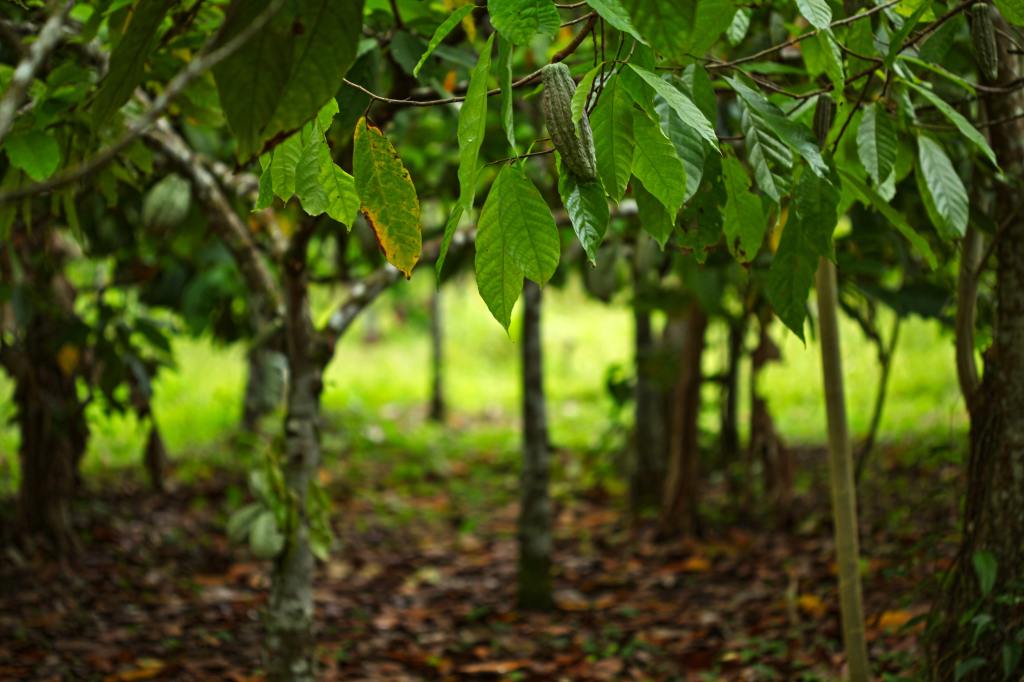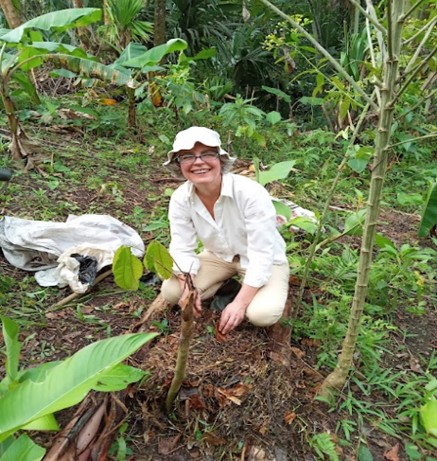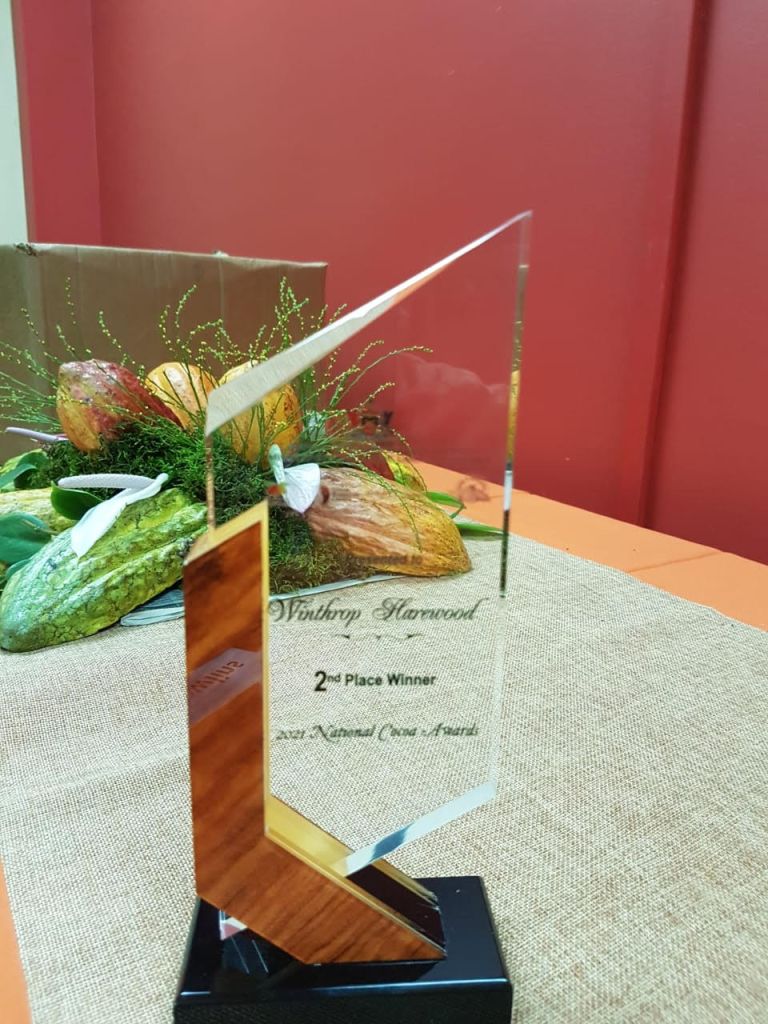
As a craft chocolate maker in Portugal, I had been thinking for a while, of visiting a cocoa farm to see not only the planting of cacao trees, but also all the processes of harvesting, cracking, fermentation, and drying of the beans. I was really interested in observing and learning what happens to cacao beans before they are bagged and shipped for me to purchase and turn into chocolate. I wanted to meet farmers – the persons that produce such an exquisite crop. I was curious and want to know- how did they start growing cacao? How and why do they continue to do so. What challenges do they experience in the cacao farming business? Reading about cacao, seeing pictures in books, and imagining how it could be is OK. I however, wanted the sensory experience of being on site, to see the land, inhale the smells, tastes the beans, and hold cacao pods in my hands.
My trip began with I participated in a CocoaTown webinar
A happy lady from Trinidad introduced herself as the sister of a cocoa farmer. She talked about her family farm and that recently, cocoa beans from their farm had been considered in the best top 50 beans in the world. I thought…, uau! I would like to visit this place.
I decided to write Wynette applying for a “farm internship”. Surprisingly, a couple of days later, she replied saying she will contact two other farmers to be part of my “internship” experience. After a dozen emails, and two calls by WhatsApp, my cocoa trip became real! Wynette organized the trip and attended to all the planning details.
In February 2022, after a very long flight from Portugal, I arrived in Trinidad. At the airport, the immigration officer asked what I was going to do in Trinidad (it was still pandemic season and may places were closed). I replied, “I’m on a cocoa trip”, and he said, “We have got the best cocoa in the world”. I replied, “I know, that´s why I am here”. My passport was stamped! Wynette met at the airport… my cocoa trip was on. It was evening. I was in the tropics, with a hot and gentle breeze.
1st farm. Jacinta and Michael Milne’s Bethany Estate @bethany_estate_tt It was wonderful to meet and stay with Jacinta and Michael. From the first minute, I felt very welcomed. Jacinta and Michael shared with great passion, the history of Bethany Estate, how they started the farm, their aims and vision, how they manage the place, what they plant, how and why they do what do.
At Bethany Estate…
…I had my first taste of the cacao pulp…hmmm! What a marvelous flavor! I will always remember this moment! I saw and tasted different kinds of fruits and vegetables, some we don´t have in Europe and I had never heard of. As we walked through the land Michael always pointed me to some vegetable or fruit tree that he had planted. Jacinta taught me to prune the cocoa trees, and I actually did a couple of cuts!
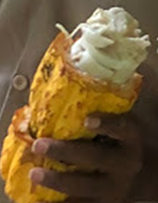
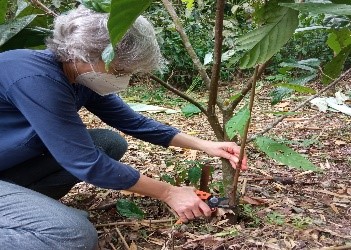
At the farm, I was introduced to Dr. Darin Sukha, from the Cocoa Research Centre of The University of the West Indies, Mathew Escalante and Siddiqa Ragbirsingh
Cocoa Development Officers at the Cocoa Development Company Limited. These individuals contribute to the development of the cocoa industry by providing invaluable outreach services, training, and research data to farmers. In spite of all the doubts and concerns about cocoa tree farming and chocolate making, I realized that farmers in Trinidad can access information and support at different stages alone the cocoa value chain.
On a lovely afternoon, we went to Yerettê-Home of the Hummingbird, where Dr. Theo Fergusson revealed to me the world of these amazing creatures. It was the first time I saw hummingbirds – they really are beautiful and special birds. The first leg of my trip ended with a visit to two chocolatiers- Cocoa Pod and Cocobel- each with different styles and approaches to the business of chocolate, but both have very good chocolate.
As a Portuguese citizen, it was a pleasure to meet and talk with Dr. Jo-Anne Ferreira, about the history of Portuguese immigration in Trinidad. I was unaware of this historical connection, so it was a great joy to be gifted with an autograph copy of her book: The Portuguese of Trinidad and Tobago: Portrait of an Ethnic Minority.
2nd farm. After Bethany, I went to Aripo, to Charamal Estate owned by Annette Mills. This farm in the mountains, is very beautiful. Annette is a tough lady driving a 4×4 pickup truck. She is always on the move, never stands still. She is always doing something or thinking about something!

Annette put me at work immediately. I picked cocoa pods, removed the beans from the pods cracked by Annette, observed how beans are prepared for fermentation and drying, washed dried fermented beans before they were packaged. I loved doing this “hands-on” work.
As well as being a farmer, Annette is also a chocolate maker. Her chocolate is produced at her home in Balandra-a village on the Trinidad’s east coast. When not working on the farm, we talked about cocoa, and chocolates and shared ideas. I even got a chance to have a lovely swim in the Atlantic Ocean.
3rd farm. From Aripo, I spent a night in Port of Spain, and left the next day for the Roods and Perches Farm in Tableland, in south-eastern Trinidad. I spend a full day with Wynette and her brother, Dr. Winthrop Harewood. They trusted me to plant 5 cocoa trees on the farm, in a place we named “Monica´s Row”.

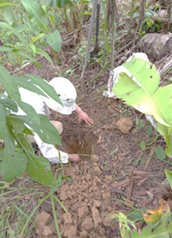


It was both an honor and a pleasure to do the planting (with some guidance from Winthrop). As we walk through the land, and picked some ripe pods from the trees, Wynette and Winthrop talked about their cocoa projects for sustainable organic cocoa farming and future plans to expand the acreage under production. I was told the trees in Monica’s Row would be bearing pods in about three years.
Before leaving Trinidad, I still had time for a one-day cultural trip in Port of Spain with Wynette and Bethany Milne to the National Museum, where I got a glimpse of the history of Trinidad, and two art galleries where I saw very good paintings from Caribbean artists. My last activity was a trip to Maracas Beach, where I had the traditional and delicious bake and shark. By the way, during the trip, I had the chance to have delicious meals! These ladies cook in fantastic ways!

Departure time. I left my work boots and most of my clothes in Trinidad and filled my backpack with cocoa beans from Roods and Perches, organic cocoa nibs from Bethany Estate and cocoa butter and cocoa powder from Charamal Estate. My backpack has never been so heavy, but it has never smelled so good either. Safely back in back in Portugal, I used some of the cocoa butter and nibs to make Easter bonbons and mendiants.


This was a wonderful experience. I learned not only about cocoa and chocolates, but also about the history, nature, art, culture, and culinary delights of Trinidad, and experienced human kindness. Thank you Wynette for organizing such a wonderful and smooth trip. I am very grateful, as this experience was like a dream come true. It was a great joy!

